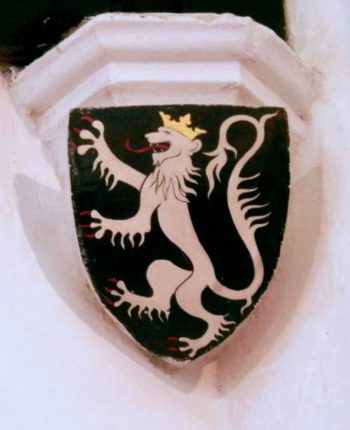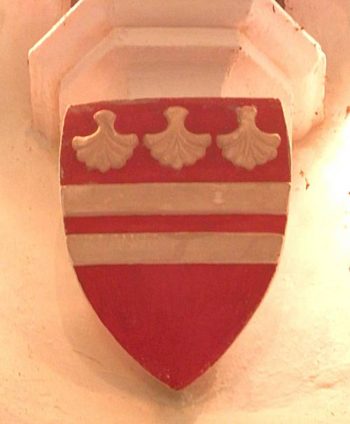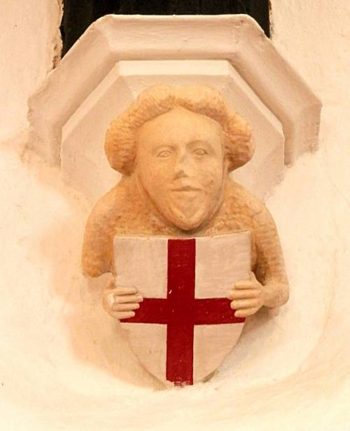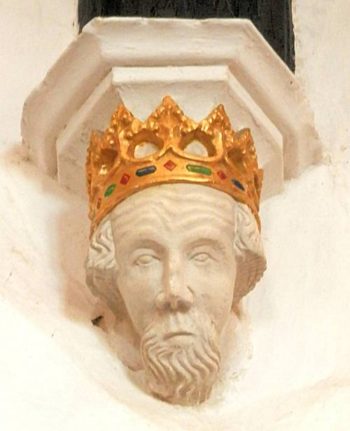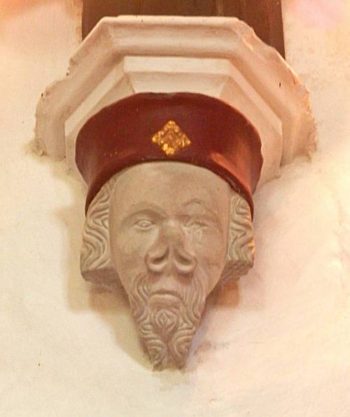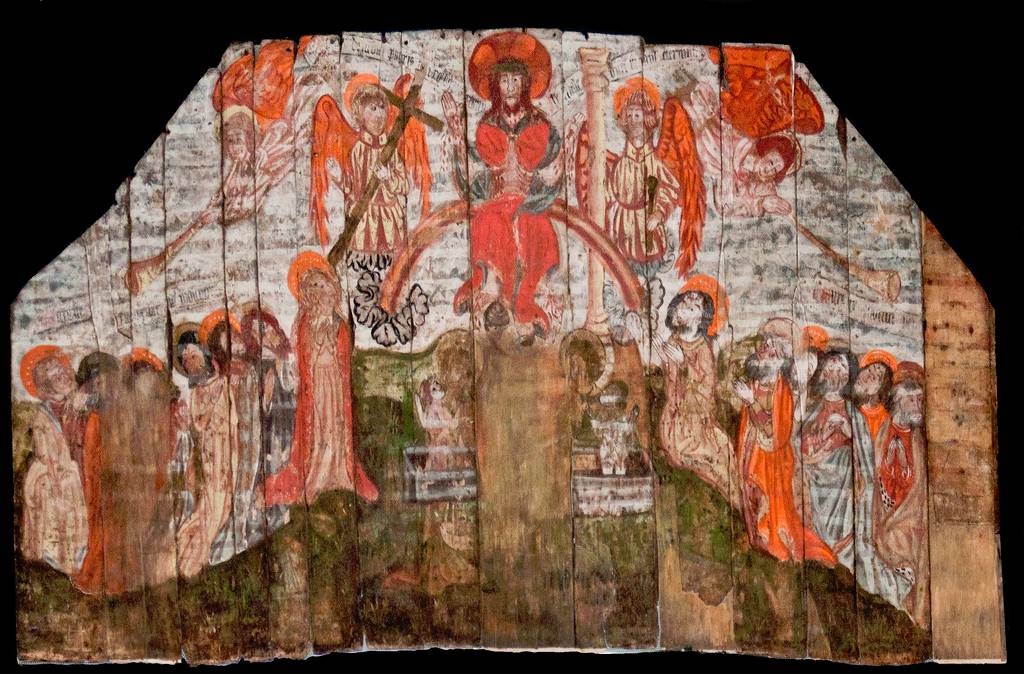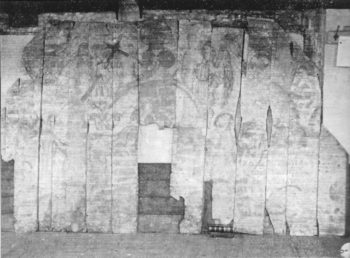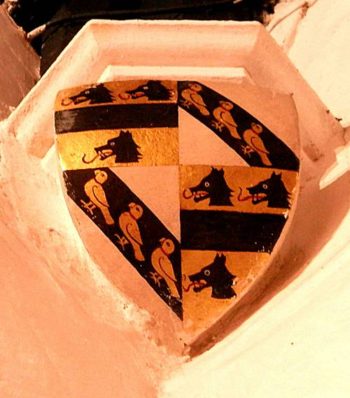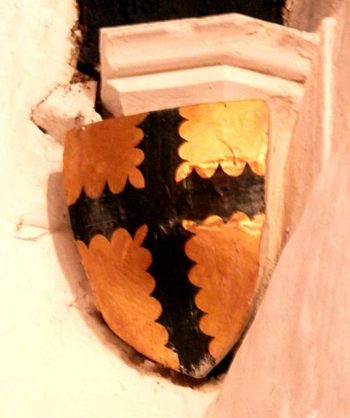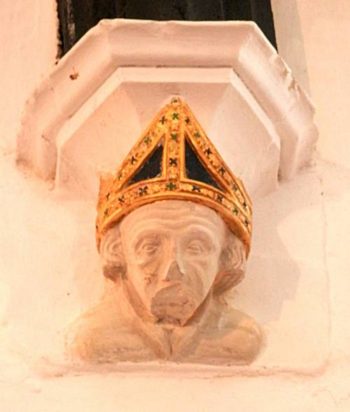When Kenneth Mumford, a newly arrived and very active Vicar, set about a general cleaning of the church in the summer of 1938, our remarkable medieval painting of the Doom or Last Judgement, 12 ft wide and 6 feet 6 inches high, on sixteen oak boards, was found high up above the chancel arch, but unrecognised since covered in whitewash and by lath and plaster.
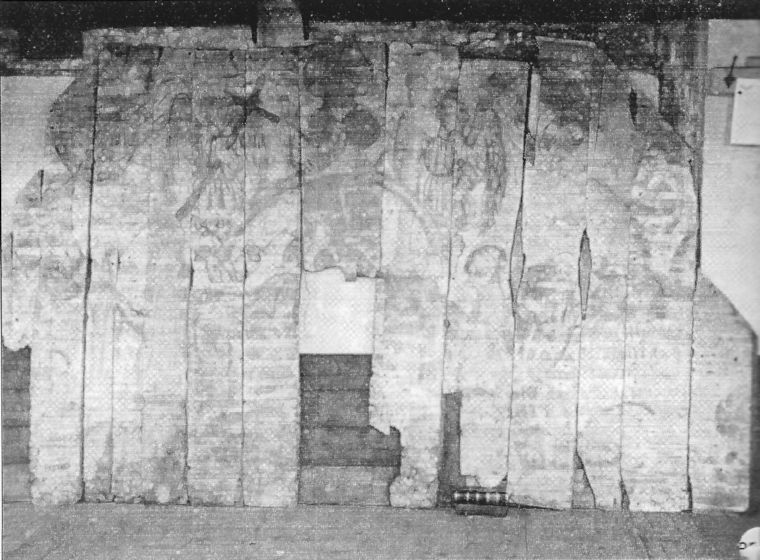
Clive Rouse, an expert on medieval church wall painting (of whom more later), wrote that the badly decayed oak boards were taken out of a ‘hole’ in the east bay of the roof above the tie-beam where they found the whitewashed oak boards covered in lath and plaster, which were further broken up and pitched outside into the churchyard ready to be carted away.
A fortnight later, a workman, Tom Randall, picked up a piece, and, taking the laths off, discovered what looked like the image of a bell inverted on it. As a result, Clive Rouse was eventually invited to go and see the find, which was set out in the old parish room.
After the laths and plaster had been removed, they saw the very dim and dingy outlines of a few figures; enough, however, to see that it was an object of the very greatest importance, and many weeks’ work resulted. What was eventually revealed was described by Clive Rouse, when he had restored the medieval oil pigment to its original freshness, as ‘the most spectacular thing of its kind in the country’, one of only five surviving medieval paintings of this type.
Kenneth Mumford died the following year after only two years in office – he had been badly gassed during the WW1 – and his obituary recorded that his associations and work in connection with the Doom painting were great, so we must give him credit for ensuring its immediate survival and layout in the Parish Room. Herbert Druce (born in 1915) remembers it all very well and confirms that Revd Mumford played an important part in the discovery of the Doom. Clive Rouse wrote that he had spent two days combing through the rubbish tip and Herbert confirms that ‘a good many pieces were found in the dell used as a parish rubbish tip in the field off Gravelly Way’ (opposite what is now called Lions Farm). I have also seen a report that some boards had been used for a pig pen.
In 1547, an Order in Council required ‘the obliteration and destruction of popish and superstitious books and images so that the memory of them shall not remain in their churches or houses.’ It was at this stage that the Doom would have been covered by limewash with lath and plaster probably added in the 1730s when the chancel and chancel arch were widened and nave roof raised.
Clive Rouse was a remarkable man, an archaeologist of national renown who specialised in medieval church wall paintings throughout Britain. He lived all his working life in Gerrards Cross – I went to talk to him there – and he was a regular contributor to Records of Buckinghamshire of which he was Editor or deputy Editor for 35 years from the 1930s and was later President of the Bucks Archaeological Society from 1969 to 1979. In the wider world, he was President of the Royal Archaeological Institute (1967-72), and the author of a multivolume series, ‘English medieval wall painting’. We were so fortunate to have such expertise on hand.
The Doom was taken down for analysis and conservation in 2002 and the next article will discuss the discoveries that were made.
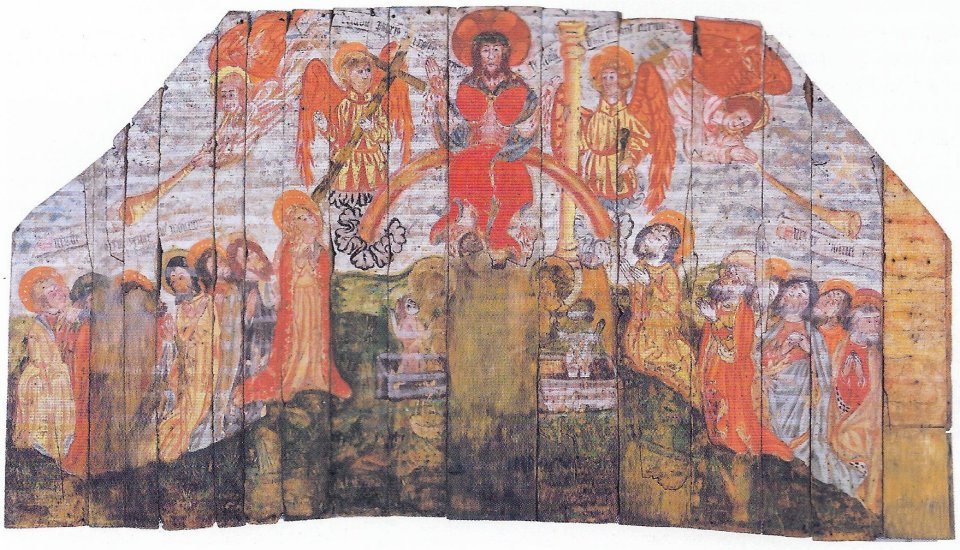
Miles Green, The Penn Doom revisited, Part 1, January 2024
The Doom revisited, Part 2 – A Millennium project
In 1999, with the millennium looming, the Penn Trust offered to pay for a technical examination and full report on the Doom to establish whether any conservation measures were needed and to find out more about the painting. A working group was set up with Christopher White, John Wood, Sir Oliver Millar, and myself, for many discussions and decisions.
The initial examination was carried out in situ by Ruth E. Bubb, a conservator of paintings. In the light of her report, it was decided to remove the Doom to her studio near Banbury in order to facilitate cleaning and treatment and allow a close analysis using all the modern techniques available – detailed analyses of the paint layers, infra-red reflectography (detects underdrawings, reveals changes in composition, damages, fillings and retouches), X-radiographs and dendrochronology (tree ring analysis) were all carried out and revealed much of interest.
We saw in my previous article that Clive Rouse, the leading national authority on church wall painting, had assembled and restored the 16 oak boards, whitewashed and covered with lath and plaster, when they were found in 1938. They were of varying width with an overlapping chamfer on each side. He discovered that the painting was a palimpsest – an earlier work of great delicacy and more elaboration, executed he thought, in tempera (egg), had been overpainted by a later, but coarser painting in crude but brilliant oil colours. He deliberately removed some of the plain painted areas of the second painting in order to reveal some crucial elements of the first. He concluded that the original painting had been a true tympanum fitting under the upper part of the medieval chancel arch, extending up into its arched apex, and widening out to its sides.
Based on the style and methods used, he dated the Doom as a re-painting of about 1480 of an earlier painting of aboutDendrochronology subsequently told us that the oak panels came from a single local oak tree about 100 years old with a diameter of about 2ft 6ins, cut down between1414 andThe style suggests the earlier date which presumably coincided with the major restructuring of the nave to create high-level clerestory windows by raising the walls by some 6 feet and adding the magnificent new roof supported on new corbels.
The conservator replaced the plain wooden inserts, which fill gaps where parts of the original boards are missing, by better fitting ones, treated to make them less conspicuous. A new, much lighter, aluminium framework was designed to support the painting. All this painstaking and expensive work amounted to some £20,000 and was possible only with the generous support of specialist charities. The Doom was sent directly from the conservator to the Victoria and Albert Museum for display for 3 months in their exhibition, The glory of Gothic: Art in England 1400-1547, and was returned to Penn early in January 2004 after a two-year absence.
We had arranged a celebratory reception and talks in the church and only a few days beforehand, with thought provoking synchronicity, a West Country picture dealer rang me out of the blue to say he had a water colour from Penn Church by a Clive Rouse, painted in the 1930s. He asked if I could tell him anything about it and assure him that it was not stolen. He was more than willing to bring it to the Doom celebration to see if anyone was interested in buying it.
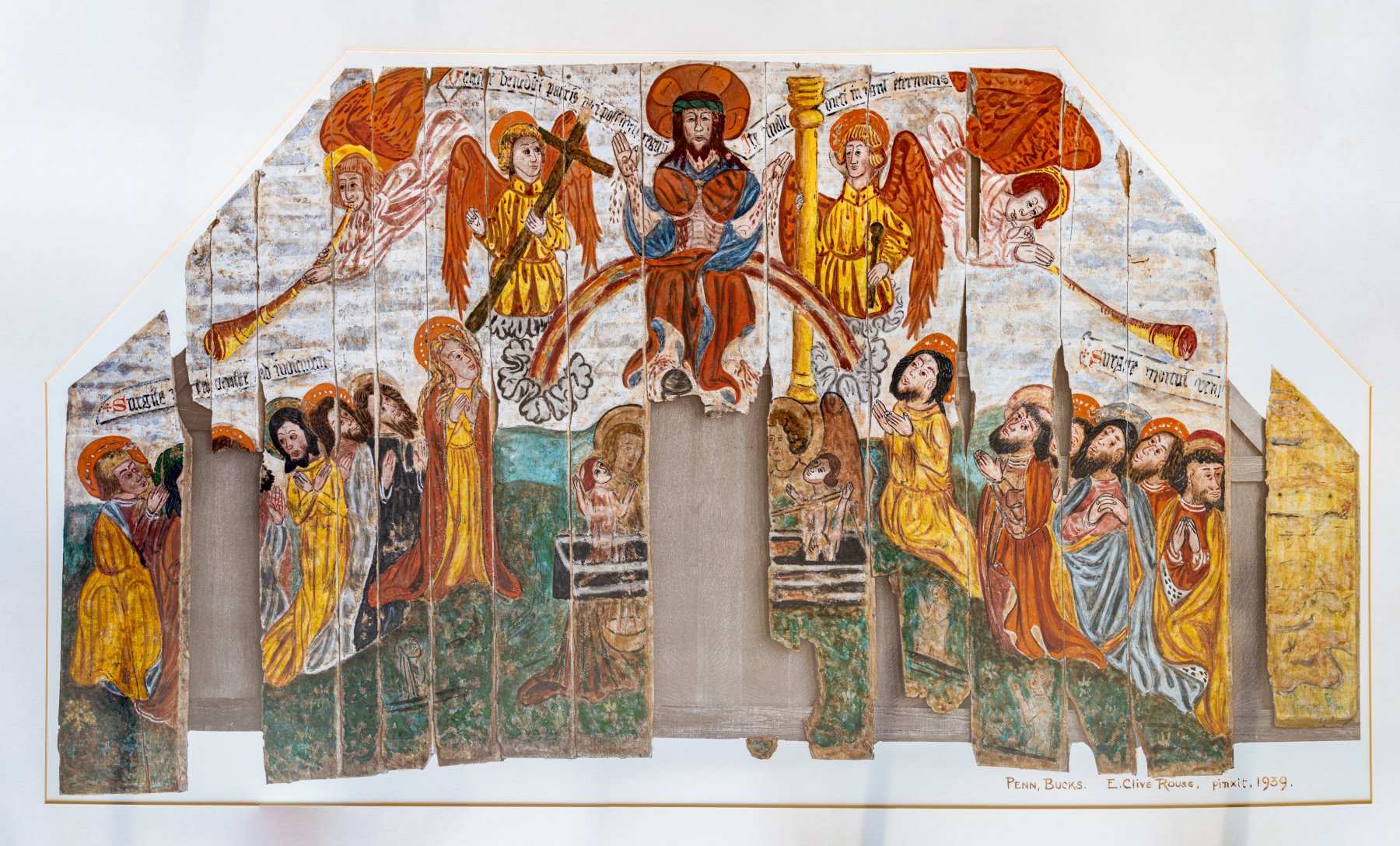 This was the painting which now illustrates this article. It is so accurate, down to the last detail, that a knowledgeable local art dealer insisted that it must be a painted photograph. Ann Ballantyne, a close colleague of Clive Rouse, was horrified at the very idea! She said he never used a photograph – he used a caliper to transfer scale from the original to his drawing so that it was completely accurate. Indeed, Rouse’s obituary speaks of the meticulous observation and accuracy of his measured water colour drawings of wall paintings, so good that they have been bequeathed to the Society of Antiquaries in Burlington House. The painting is exactly one quarter size of the original and mirrors every detail giving it the clear and bright image that the congregation would have seen when it was first raised.
This was the painting which now illustrates this article. It is so accurate, down to the last detail, that a knowledgeable local art dealer insisted that it must be a painted photograph. Ann Ballantyne, a close colleague of Clive Rouse, was horrified at the very idea! She said he never used a photograph – he used a caliper to transfer scale from the original to his drawing so that it was completely accurate. Indeed, Rouse’s obituary speaks of the meticulous observation and accuracy of his measured water colour drawings of wall paintings, so good that they have been bequeathed to the Society of Antiquaries in Burlington House. The painting is exactly one quarter size of the original and mirrors every detail giving it the clear and bright image that the congregation would have seen when it was first raised.
Despite initial enthusiasm and a public notice, there were no offers to buy it, for reasons of both the cost and security risk if displayed publicly. I found that I could not bear the thought of losing such an important reminder of this marvellous project which had so enjoyably occupied my time and energies for several years, and when, after several weeks of unexpected silence, the picture dealer rang, it was to say that he accepted my offer. And so, with continuing thoughtprovoking synchronicity, it was on Good Friday and over the Easter weekend, the very subject of the Doom painting, that 20 years ago I organised its purchase.
Miles Green, April 2024
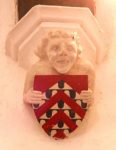 1)The Turville arms, nearest to the porch (on a demi-man with a high collar and spiky hair holding a shield) are those of the family who were the overlords of the Pennes (see Part 16) and who held the patronage of the church in its early years.
1)The Turville arms, nearest to the porch (on a demi-man with a high collar and spiky hair holding a shield) are those of the family who were the overlords of the Pennes (see Part 16) and who held the patronage of the church in its early years.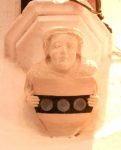 2) The Penn arms (on a demi-man in a cap and knitted pullover, holding a shield). The arms first appear in written records in about 1308 when the parliamentary Roll of Arms assigns ‘Argent, on a fess sable, 3 plates to Sire Johan de la Penne’. He was twice Knight of the Shire for Buckinghamshire but his forbears were also of the knightly class, and the arms are likely to date from the early years of heraldry at least a century earlier.
2) The Penn arms (on a demi-man in a cap and knitted pullover, holding a shield). The arms first appear in written records in about 1308 when the parliamentary Roll of Arms assigns ‘Argent, on a fess sable, 3 plates to Sire Johan de la Penne’. He was twice Knight of the Shire for Buckinghamshire but his forbears were also of the knightly class, and the arms are likely to date from the early years of heraldry at least a century earlier.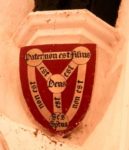 3) A symbol of the Holy Trinity. I suggested (Part 4) that the original dedication of the church may not have been to the Holy Trinity.
3) A symbol of the Holy Trinity. I suggested (Part 4) that the original dedication of the church may not have been to the Holy Trinity.
